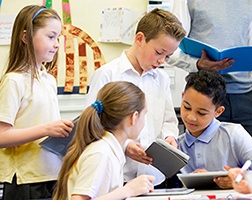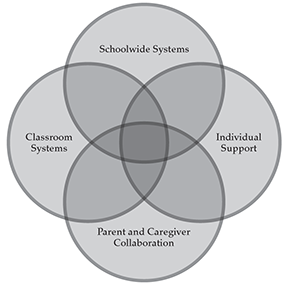
The overwhelming feelings of fear and insecurity rise into my throat as I stare into my plan book, pencil tapping away at the empty space where my first week of instruction should be. When do I start with my content areas? When are the materials arriving? Will we have test scores by then to begin grouping? I’m getting ahead of myself.
After several long, deep breaths, I begin to remember what these first weeks are really about. I won’t be overwhelming my students with an explicit lesson on narrative writing during day one. I won’t be diving into comprehension quizzes on day two. I must go slow to go fast. Establish norms. Build my classroom community.
Think About the Big Picture
I’m lucky to have quick access to a copy of Best Behavior where author Jeffrey Sprague outlines the importance of strong systems which rely upon one another to facilitate academic achievement. This interconnected model is a system of symbiotic components, creating structure at every level to support all students. A classroom teacher can support this model by crafting a classroom system to meet the school-wide system. For many schools, the overarching system is the Positive Behavior Interventions and Supports (PBIS) model, which creates a simple guide that adapts easily to any classroom. At its core, PBIS is about communicating explicit expectations and following up with predictable actions to appropriate and inappropriate behaviors.
But My Kids Are Special

I know. Your class is unique, my class is unique, and everyone has their own bundle of little snowflakes to keep cool. There is no Venn diagram for what many of us are dealing with but you always know what’s best for your students, and that’s the beauty of creating your own meaty classroom system from the PBIS skeleton, or whatever your school uses.
Sprague describes tiers of student needs. At the bottom, we have a majority of students who need little support. In the middle, we see some students who require a bit of intervention. At the top, we find the few students who require intensive interventions and behavioral plans. But we can’t forget about the whole group Continuing to notice and praise appropriate behaviors while working to diffuse a possible behavioral incident maintains the sense of classroom control, letting the majority know they are on target and helping the student in need understand what is acceptable and what is not.
So, Where’s the Community?
The moment students are introduced to the classroom and its expectations, some form of community is created. It’s up to us as teachers to facilitate the establishing of classroom community each year and determine what kind of community it will be. So how are we going to link positive behavior and classroom management to community? We let the students create that part.
You still have your overarching school-wide system, PBIS, or whatever it is, but students get the opportunity to discuss and outline their own expectations for the classroom. This can include discussions on how students feel they learn best. In the process, they take on the responsibility. They become accountable.
- Use chart paper to jot down their ideas for what the ideal classroom looks and sounds like.
- Allow groups to come up with guidelines and let the whole group vote on the most important “articles” for a sort of classroom constitution.
- Create something they all agree upon and keep themselves and each other accountable for upholding.
- Refer back to this class agreement when the going gets tough or to praise the group for upholding their promises to one another.
Community Circles
You have established your expectations, students have discussed and agreed upon their classroom norms, and a foundation of accountability has been created. How do you keep it going? Community circles are whole group discussions that can help a team air individual grievances, students can ask for forgiveness, and the group can celebrate successes. In some classrooms or schools, this practice can fall under the category of “restorative justice.” A model which allows behavioral offenders to reconcile with those affected. This method can also facilitate conflict resolution, team rehabilitation, and helps a group form bonds by allowing open communication and whole group participation.
 Every group is unique and individual student needs as well as whole group goals must be taken into account when establishing a community circle practice. No matter your situation, here are a few guidelines to consider:
Every group is unique and individual student needs as well as whole group goals must be taken into account when establishing a community circle practice. No matter your situation, here are a few guidelines to consider:
- One person talks at a time during community circle (as indicated by a “talking stick” or other speaker device).
- Respect the speaker by giving them your eyes and ears.
- Not everyone is required to speak, you may always pass to the next person in the circle.
Discussions in community circle can include recognitions for other students or groups. Students should be able to describe why this person is being recognized. Go back to your agreements. Who is doing things well? This is also a time for students to apologize to the group for inappropriate behavior and talk about goals for the following week. Sentence stems can offer support for those who struggle to communicate their point.
Community Circle Topics or Sentence Starters:
- I would like to recognize (student) for (specific action) which showed (character trait).
- I would like to apologize to (student/class) for (specific reason). I take responsibility by (reparation).
- Next week I hope (I/we) can (goal).
Make it Yours, and Theirs
No matter the route taken for classroom management and community building, student needs must always be considered. No one knows these needs better than the educators leading them. Build a classroom system with student success in mind and you can have a classroom that gets things done. Build a classroom community and you can have a group of individuals who take ownership of their role in their own learning as well as the learning of others.
Building a climate where all students can reach their potential requires a comprehensive system of positive behavior interventions and supports (PBIS). Voyager Sopris Learning provides resources that promote caring and respect in the classroom and address behaviors that distract from teaching and learning:



